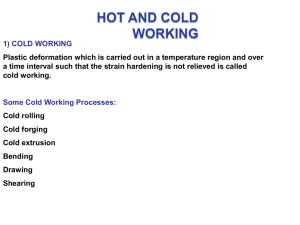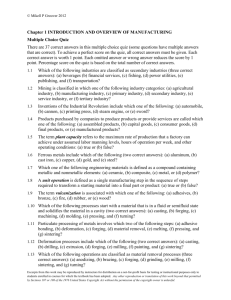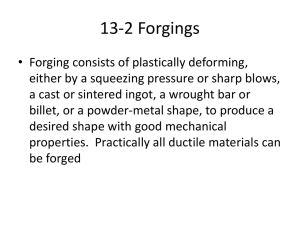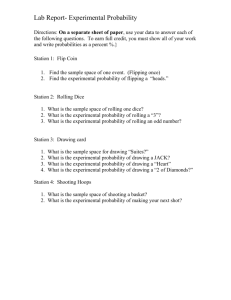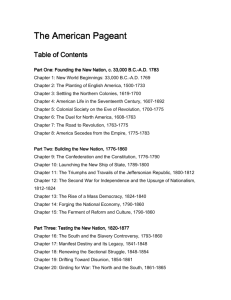Metal Forming Processes Introduction Dr. Sunil Jha
advertisement
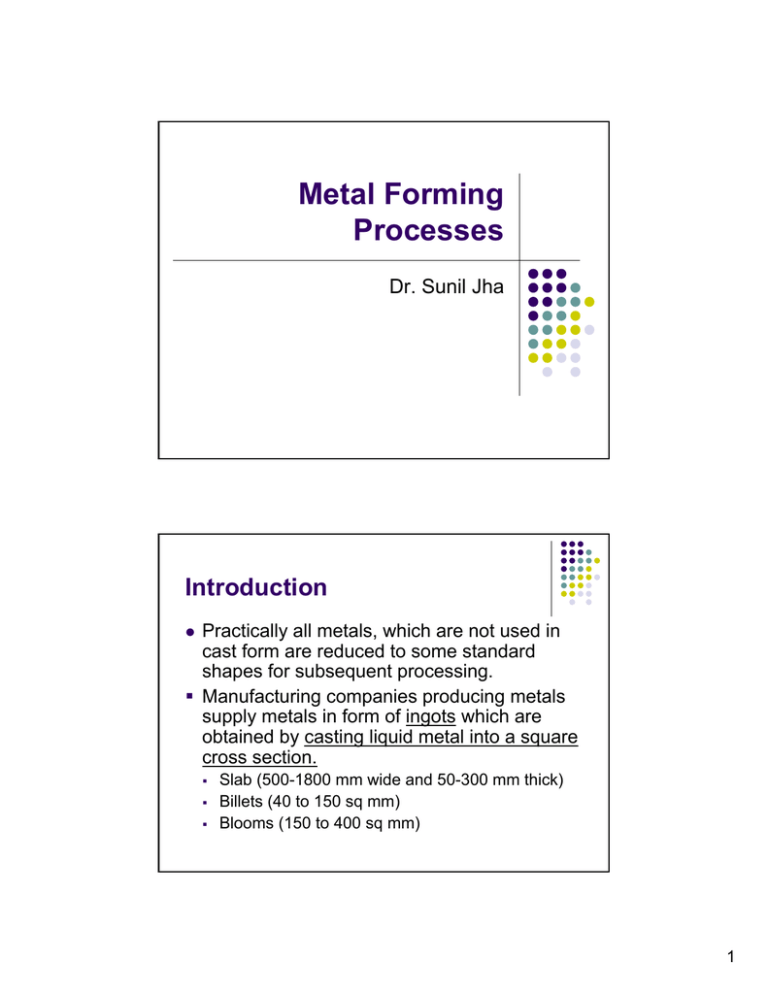
Metal Forming Processes Dr. Sunil Jha Introduction Practically all metals, which are not used in cast form are reduced to some standard shapes for subsequent processing. Manufacturing companies producing metals supply metals in form of ingots which are obtained by casting liquid metal into a square cross section. z Slab (500-1800 mm wide and 50-300 mm thick) Billets (40 to 150 sq mm) Blooms (150 to 400 sq mm) 1 Introduction Sometimes continuous casting methods are also used to cast the liquid metal into slabs, billets or blooms. These shapes are further processed through hot rolling, forging or extrusion, to produce materials in standard form such as plates, sheets, rods, tubes and structural sections. Sequence of operations for obtaining different shapes 2 Different Shapes Primary Metal Forming Processes z z z z z z Rolling Forging Extrusion Tube and wire drawing and Deep drawing Although Punching and Blanking operations are not metal forming processes however these will be covered due to similarity with deep drawing process. 3 Rolling Change in Grain Structure in Rolling 4 Rolling – Salient features z z z z Rolling is the most extensively used metal forming process and its share is roughly 90% The material to be rolled is drawn by means of friction into the two revolving roll gap The compressive forces applied by the rolls reduce the thickness of the material or changes its cross sectional area The geometry of the product depend on the contour of the roll gap Rolling – Salient features z z Roll materials are cast iron, cast steel and forged steel because of high strength and wear resistance requirements Hot rolls are generally rough so that they can bite the work, and cold rolls are ground and polished for good finish 5 Roll passes to get a 12 mm rod from 100 x 100 mm billet Roll configurations in rolling mills z z Two-high and three-high mills are generally used for initial and intermediate passes during hot rolling, while four-high and cluster mills are used for final passes. Last two arrangements are preferred for cold rolling because roll in these configurations are supported by back-up rolls which minimize the deflections and produce better tolerances. 6 Various Roll Configurations (a) Two-high (b) Three-high (c) Four-high (d) Cluster mill (e) Tandem mill Other deformation processes related to rolling 7 Defects in Rolling Forging z z z Forging is perhaps oldest metal working process and was known even during prehistoric days when metallic tools were made by heating and hammering. Forging is basically involves plastic deformation of material between two dies to achieve desired configuration. Depending upon complexity of the part forging is carried out as z z open die forging and closed die forging. 8 Open Die Forging z In open die forging, the metal is compressed by repeated blows by a mechanical hammer and shape is manipulated manually. Closed Die Forging z z In closed die forging, the desired configuration is obtained by squeezing the workpiece between two shaped and closed dies. On squeezing the die cavity gets completely filled and excess material comes out around the periphery of the die as flash which is later trimmed. 9 Press & Drop Forging z z Press forging and drop forging are two popular methods in closed die forging. In press forging the metal is squeezed slowly by a hydraulic or mechanical press and component is produced in a single closing of die, hence the dimensional accuracy is much better than drop forging. Flash less Forging or Precision Forging 10 Defects in Forging Extrusion z z z It is a relatively new process and its commercial exploitation started early in the nineteenth century with the extrusion of pipes. In extrusion, the material is compressed in a chamber and the deformed material is forced to flow through the die. The die opening corresponds to the cross section of the required product. It is basically a hot working process, however, for softer materials cold extrusion is also performed. 11 Direct & Indirect Extrusion z z z In direct extrusion metal flows in the same direction as that of the ram. Because of the relative motion between the heated billet and the chamber walls, friction is severe and is reduced by using molten glass as a lubricant in case of steels at higher temperatures. At lower temperatures, oils with graphite powder is used for lubrication. In indirect extrusion process metal flows in the opposite direction of the ram. It is more efficient since it reduces friction losses considerably. The process, however, is not used extensively because it restricts the length of the extruded component. Impact Extrusion z z z z It is similar to indirect extrusion. Here the punch descends rapidly on to the blank which gets indirectly extruded on to the punch and to give a tubular section. The length of the tube formed is controlled by the amount of metal in the slug or by the blank thickness. Collapsible tubes for pastes are extruded by this method. 12 Drawing z z Large quantities of wires, rods, tubes and other sections are produced by drawing process which is basically a cold working process. In this process the material is pulled through a die in order to reduce it to the desired shape and size. In a typical wire drawing operation, once end of the wire is reduced and passed through the opening of the die, gripped and pulled to reduce its diameter. Wire Drawing z z z By successive drawing operation through dies of reducing diameter the wire can be reduced to a very small diameter. Annealing before each drawing operation permits large area reduction. Tungsten Carbide dies are used to for drawing hard wires, and diamond dies is the choice for fine wires. 13 Tube Drawing z z z Tube drawing is also similar to wire drawing, except that a mandrel of appropriate diameter is required to form the internal hole. Here two arrangements are shown in figure (a) with a floating plug and (b) with a moving mandrel The process reduces the diameter and thickness of the tube. Deep Drawing z This operation is extensively used to for making cylindrical shaped parts such as cups, shells, etc from sheet metal. 14 Defects in Drawing (a)Wrinkling in the flange or (b) in the wall (c) tearing, (d) Earing, (e) surface scratches Wrinkling Prevention z z z z z Wrinkling is avoided by applying a blank holder force through a blank holder. Blank holder force increases friction and hence the required punch load. Therefore, blank holder force should be just enough to prevent wrinkling of the flange. The edges of the punch and die are rounded for the easy and smooth flow of metal. Sufficient clearance is also provided so that sheet metal could be easily accommodated. Insufficient or large clearance may result into shearing and tearing of sheet. A drawn cup can be redrawn into a smaller cup but it must be annealed to prevent failure. 15 Punching & Blanking z z Objective of punching and blanking is to remove material from the sheet metal by causing rupture, the punch and die corners are not provided with the any radius. Tool steel is the most common material for tool and die. Carbides are also used when high production is needed. Punching & Blanking 16
